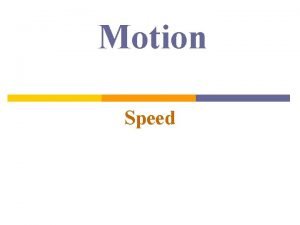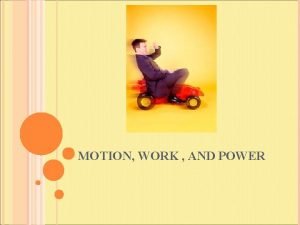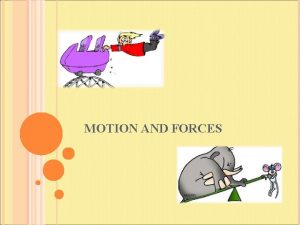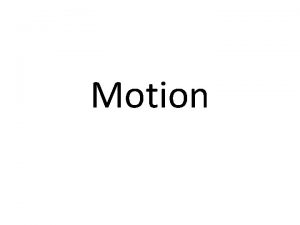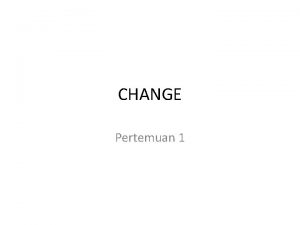Motion Science 10 Motion Motion is the change















- Slides: 15

Motion Science 10

Motion ► Motion is the change of an object’s location during a period of time ► An applied force often causes motion

Motion continued ► Motion can be one dimension § Dropping a ball: the ball falls vertically = one direction ► Motion can be two dimensions § Throwing a ball: the ball falls vertically and moves horizontally ► Motion can be circular § Moon’s orbit around Earth

Key Terms: ► Reference point: a starting point used to describe the location / position of an object § The initial point ► Distance: d the total length between two points or the total length travelled including every twist and turn travelled ► Position: an object’s distance and direction from a reference point

Key Terms: ► Scalar: a quantity that has only magnitude (size) (no direction) § Distance, time and temperature all scalars ►Example: 30 km/h ► Vector: a quantity that has both magnitude (size) and direction § Displacement and position are both vectors § Vectors are shown with an → above the letter ►Example: 30 km/h [West]

Distance ► The standard unit for distance is the meter (m) ► Symbols: d (distance) (initial distance) (final distance) (change in distance) ► Delta ( ): means change in So:

Position ► Position: Describes an object’s location, as seen by an observer from a particular viewpoint. ► Symbols: : initial position : final position ► Standard unit: meter (m) § Example: The school is 200 m [E] of Sarah’s house

Distance / Position Time Graph Position = 0 : reference point Positive Position: Distance up or right from the reference point ► Negative Position: Distance down or left from the reference point ► ►

Direction ► Direction: Objects that move in a straight line, in only one dimension, either backwards or forwards or up or down is called linear motion. Direction is shown using a + or a -. § A + indicates up or to the right of the starting point (can also be north or east) § A – indicates down or to the left of the starting point ( can also be south or west)

Examples: • The reference point is the hydrant because it is at 0 m • When the runner is at 9 m her position is +9 m • When the runner is 5 m west of the hydrant position is -5 m West East

Displacement ► Displacement: the change in position: the difference between initial position and final position § Describes how much an objects position has changed § Measures the shortest path (straight line from initial position to final position) § Displacement is a vector (has both magnitude and direction) ►If an object ends up exactly where it started, like a runner running around a track, the displacement is zero, even if it has moved a long way.

Displacement ► Symbols: ► (change in position or displacement) So:

Displacement ► Example: ► Than: and

Time Describes when an event occurs ► Standard unit is the second (s) ► Time interval describes the duration of an event ► Time is a scalar since it does not have direction ► § ► Example: 50 s Symbols: t (time) (initial time) (final time) (time interval) So:

Distance vs Time
 My favourite subject computer
My favourite subject computer Hình ảnh bộ gõ cơ thể búng tay
Hình ảnh bộ gõ cơ thể búng tay Frameset trong html5
Frameset trong html5 Bổ thể
Bổ thể Tỉ lệ cơ thể trẻ em
Tỉ lệ cơ thể trẻ em Voi kéo gỗ như thế nào
Voi kéo gỗ như thế nào Tư thế worm breton
Tư thế worm breton Alleluia hat len nguoi oi
Alleluia hat len nguoi oi Các môn thể thao bắt đầu bằng tiếng nhảy
Các môn thể thao bắt đầu bằng tiếng nhảy Thế nào là hệ số cao nhất
Thế nào là hệ số cao nhất Các châu lục và đại dương trên thế giới
Các châu lục và đại dương trên thế giới Công thức tính độ biến thiên đông lượng
Công thức tính độ biến thiên đông lượng Trời xanh đây là của chúng ta thể thơ
Trời xanh đây là của chúng ta thể thơ Mật thư anh em như thể tay chân
Mật thư anh em như thể tay chân Làm thế nào để 102-1=99
Làm thế nào để 102-1=99 độ dài liên kết
độ dài liên kết


















